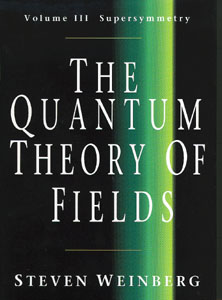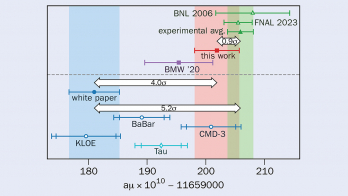by Steven Weinberg, Cambridge University Press, ISBN 0 521 66000 9 (hbk £32.50/$49.95).

The third volume in Steven Weinberg’s very successful collection on “The Quantum Theory of Fields” covers the topical area of supersymmetry and appears three years after the celebrated opening ones on “Foundations”(1995) and “Modern applications (1996). If these two volumes were considered masterpieces in a modern and original presentation of the basics of quantum field theory and its penetration in the recent development of particle physics, with the machinery of spontaneously broken gauge theories, the new volume embraces the wide subject of supersymmetry in Weinberg’s typical style, which always means a self contained treatment of the subject, from its foundations and motivations, to its most recent application as a possible scenario for new physics beyond the Standard Model (SM).
Weinberg’s main motivation for “Supersymmetry”as a quest for a unified theory relies on the possible solution of the so-called hierarchy problem, that is, the explanation of the “mystery” of the enormous ratio between the electroweak scale (around 300 GeV) and the Planck scale (1019GeV). It is worth noticing that such a fine-tuning problem, which calls for new physics at the TeV scale and is one of the main reasons for future searches at the LHC under construction at CERN, was raised by Weinberg himself in a famous paper with Eldad Gildener (1976 Phys. Rev.D13, 3333), and by two more of the main contributors to the modern theory of electroweak and strong interactions, Martinus Veltman (1981 Acta Phys. Polon.B12 437) and Luciano Maiani (1979 Proc. Summer School of Gif-sur-YvetteIN2P3 1).
Supersymmetry is the only known example of the enlargement of the space-time symmetry of physical laws (the so-called Poincaré symmetry based on Einstein’s special relativity), which is consistent with all axioms of relativistic quantum field theory. In so doing it unites particles of different spin, thus predicting a variety of new species when applied to the SM of the electroweak and strong interactions.
Weinberg’s exposition (in chapters 24-32) starts with a synthetic but complete presentation of the mathematical foundations of supersymmetry, called “graded Lie algebras”, which is a generalization of the concept, more familiar to physicists, of Lie algebras and continuous Lie groups (chapter 25).
As a preliminary to the above, he recalls in chapter 24, with an original presentation, the “no-go” theorems, which are the basis of the (failed) attempts, prior to supersymmetry, to unite space-time with internal symmetries (such as isospin or SU(3) eightfold way symmetries). He then undertakes, in chapter 26, supersymmetric field theories, using superfields, that is fields living in superspace, an abstract space that unifies space-time points with anticommuting coordinates, able to encompass multiplets of particles with different statistics and spin. In chapter 27, he develops the subject of supersymmetric gauge theories, which realize the remarkable marriage between the principle of local Yang-Mills symmetry with supersymmetry.
The way in which Weinberg exposes the subject, with all of its subtleties and technical details, is spectacular. He covers non renormalization theorems, supersymmetry breaking and extended supersymmetry with an original, clear and self-contained presentation. He then develops, in chapter 28, supersymmetric versions of the SM, covering most of the problems at the core of today’s search forsupersymmetry in particle physics, namely the scale of supersymmetry breaking, the minimal supersymmetric SM, possible baryon- and lepton-number violation and gauge-mediated supersymmetry breaking.
In the last four chapters, Weinberg develops more theoretical aspects of supersymmetric field theories, which are, however, tremendously important to the theoretical motivation of supersymmetry and its role in the formulation of quantum theories of gravity.
General aspects of supersymmetry beyond perturbation theory are touched on in chapter 29, with the modern developments of electric-magnetic duality. The latter allows us to give “exact results” for the low-energy action of certain supersymmetric field theories that exhibit a Coulomb phase for the Higgs field (the Seiberg-Witten solutions).
The following chapters are devoted to Feynman rules for supersymmetric field theories (chapter 30), an elegant presentation of supergravity theory (chapter 31) and its essential aspects, from the weak-field limit to local supersymmetry to all orders and the basic role of the gauge field predicted by supergravity, the spin-3/2 gravitino, in gravity-mediated supersymmetry-breaking scenarios.
The final chapter is devoted to supersymmetry in high space-time dimensions and the merging role of extended objects, called p- branes, in the description of modern gauge theories as coming from more general schemes such as higher-dimensional supergravities, M-theory and string theory.
The book also contains, at the end of each chapter, “problems” for the reader to exercise in the subject, even giving alternative proofs of derived results. In this respect the book, like the two preceding volumes, is well suited to graduate students in physics and applied mathematics as well as researchers who want to get acquainted with the fascinating subject of supersymmetry.
The author has achieved in a superb way the important task of producing a volume on supersymmetry, building a bridge between a formal development and its most important applications in particle physics, through a self-contained and very original sequence of subjects and topics.
To conclude this review, let us recall some indirect experimental signals, alluded to also in different parts of Weinberg’s book, indicating that supersymmetry is a plausible scenario for new physics beyond the SM:
* the non-observation of proton decay via a neutral pion and a positron, excluding a minimal Grand Unified Theory (GUT);
* the LEP precision measurements, incompatible with gauge-coupling unification for conventional minimal GUTs, but in reasonable agreement with minimal supersymmetric GUTs, with supersymmetry broken at the TeV scale;
* the large top Yukawa coupling, unusually large compared with all other quark and lepton couplings;
* the possible solution of the dark-matter problem with some of the natural supersymmetric particles (the neutralinos) as natural dark-matter candidates (WIMPs).
Although none of these facts is per se a compelling reason for supersymmetry and alternative explanations may be found, it is fair to say that they can all be interpreted in the context of a supersymmetric extension of the SM. Whatever the final theory for quantum gravity may be, supersymmetry remains a deep and non-trivial extension of our concept of space-time symmetries.








